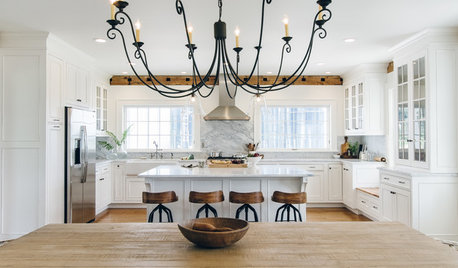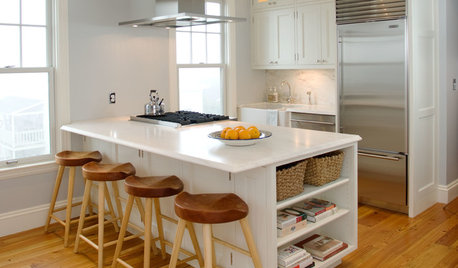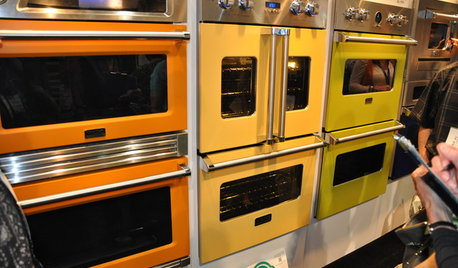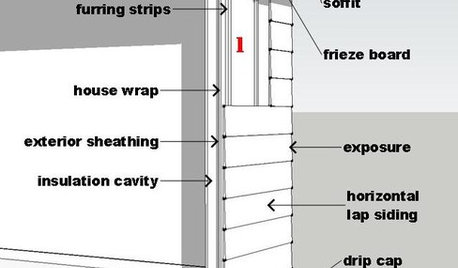poor performance from Andersen windows
Just wanted to warn people to think twice about Andersen windows if they live in an area where the temperature gets below freezing. We built a new home last year and our designer recommended Andersen 400 series windows. Since we had never really heard of problems with them, we didn't question his advice. If we had it to do over, there is no way we would use them. The tilt-in system (for washing) is a rinky-dink plastic thing that I don't expect will last long. When I press on the panes to wash them, I get that glass-crackling noise that sounds as though the panes are not securely attached to the frames. When the temperature gets below freezing, there is a strip of heavy condensation at the bottom and starting up the sides of each pane. We used a dehumidifier last year and that seemed to help some, but that made everything else too dry - wood floors, plants, skin. That leads me to believe our house is not overly-humid, these windows just aren't doing the job they're supposed to do. We had replacement windows put into our old house and never had this problem. Of course, Andersen excludes condensation damage from their warranty. I hope this saves someone else from having to deal with these problems.
Comments (25)
jean222
Original Author15 years agolast modified: 9 years agoI'm sorry, I'm new to this forum. What does "Here we go again!" mean?
Related Professionals
Castro Valley Window Contractors · Atlantic Beach Window Contractors · Matteson Window Contractors · Naples Window Contractors · North Hollywood Window Contractors · Town 'n' Country Window Contractors · Three Lakes General Contractors · Burlington General Contractors · Casas Adobes General Contractors · Hayward General Contractors · Mankato General Contractors · New Carrollton General Contractors · Rancho Santa Margarita General Contractors · Atlanta Carpenters · Morristown Carpentersskydawggy
15 years agolast modified: 9 years agoJust kidding!!! Whenever someone posts negative feedback about Andersen or Pella, a huge debate usually ensues.
Thanks for posting your experience. I'm sorry you are having this problem after spending a lot of money. Hopefully an Andersen Dealer/Installer will get on here and explain to you how this is an isolated problem that was caused by a dopey installer and not their product.
User
15 years agolast modified: 9 years agoI'm having this problem too. Our house is only 7 months old. I wondered too about those plastic things. Some of the windows I have a REALLY hard time getting them to tilt. I was told "it's just new."
jean222
Original Author15 years agolast modified: 9 years agosheesharee,
It would seem to me that the windows should open and tilt the most easily when the house is new, before it has settled enough to affect the windows. Check to see if the windows are square - level and plumb. If not, you may have an issue with the builder; if so, you may have an issue with the manufacturer. Good luck.jean222
Original Author15 years agolast modified: 9 years agoskydawggy,
Thanks for the clarification. It just seems to me that with the price of windows these days, they should be able to make one that blocks the conduction of cold between panes to a reasonable degree.I also feel between a rock and a hard place because energy-efficiency advisers say to increase the humidity in your home in the winter, block infiltration of outside air, and minimize the use of exhaust fans. Conversely, window manufacturers say to decrease the humidity, provide a source of fresh air, and use exhaust fans regularly.
calbay03
15 years agolast modified: 9 years agoHi Jean222,
It seems the people who passed on those "recommendations" either did not know or did not bother to explain the details behind their statements. In fact, I am sort of surprised by an "energy efficiency" expert recommending increasing humidity in our home without more details; huh!?
Our A/C creates "cool" air by removing moisture from the air. With significantly lower moisture level, moisture leaves our skin faster and that results in cooling sensation. May be this "expert" is implying that by injecting moisture into indoor air, resulting in rise in humidity, it will slow the skin evaporation rate causing us to feel "warmer". Unfortunately, for this to work, it requires a certain amount of heat in the air to sustain the humidity. There is no point pumping a bucket of water into a house that is 60-F or cooler. The water will just condense a few meters from the pot and "rain" onto the floor. Some families may be willing to do this but I am not much into raising the temperature to a certain point just to hold a certain amount of humidity to give that perfect ambient temperature. It is not realistic in practice unless there is something that automates the whole process.
As for the windows manufacturers, they are not worrying about your energy cost or practical ways to keep you comfortable. They are worrying about using precise legal language to protect their warranty. They prefer little humidity so that their windows do not have moisture problems and therefore reduce or eliminate problems for them.
In practice, I will suggest that you can feel free to ignore these silly suggestions and separate the need to maintain and protect the windows from the need to be comfortable and yet be energy-efficient.
If you have south facing windows, and the sun can reach into the house through these windows, you are well on your way to energy efficiency. Open the curtains, let the sun in, let it heat the interior of your house. The low-E coating on the window will work after sunset to keep the thermal radiation in your house. After night fall, you will be balmy and comfy inside with only little to some demand on the heating system.
Unless your house is especially dry, an unusual situation for a normal household, then humidity often takes care of itself. Just boiling a pot of water will inject water into the air easily. We also run the toilet, take showers, wash our hands, wash clothes and run our dryer too at low heat mode. Our house easily reaches 40% to 50% humidity level w/o us working at it. Use a humidity meter to help you see the level.
Often, long hot bath, long hot showers, hot wash or even some low-heat dryer can introduce excessive moisture into the air. Too much of that causes condensation. Then it is just common sense to turn on the vent to remove some of that moisture. Running the vent for a little while, in an enclosed bathroom, will not cost significant loss in warm air or significant increase in heater use. As long as we are not running the vent for 8 hours at full blast!
I think energy conservation can be achieved with the above practical and realistic approaches. Just using Low-E double pane argon-filled windows, properly installed and insulated, will already buy a ton of conservation values. Other more meaningful changes are radiant heat, solar water heater or on-demand water heater or PV solar power to run our heater and A/C. It has little to do with humidity and running our vents!
I am not a window expert so I will not venture any wild guesses about why there is condensation on your windows.
oberon476
15 years agolast modified: 9 years agojean222,
If I wanted to increse the likelihood of mold growing in a home, I would increse the humidity level, limit the use of exhaust fans, and block infiltration of outside air. A tight house without adequate air exchange is a wet house. A tight house without adequate air exchange is going to become a very unhealthy house.
On the other hand if I wanted to improve the indoor air quality of a home I would be inclined to decrease the humidity, provide a source of fresh air, and use exhaust fans regularly.
I agree with Calbay 100% that you should ignore some very silly advice from your energy-efficiency adviser(s).
And if you feel so inclined to read further, here is the long version of why you are dealing with this issue....
You have interior condensation on your windows simply because the surface temperature of the window is below the dew point temperature of the air in your home - a simple explanation that doesn't explain a thing.
Why the surface temperature of your windows (glass) is below the dew point temperature of the air in your home is the real question, and I am going to offer a few thoughts and maybe even throw in a few numbers that I hope might help your situation.
In the summer, when you pull something cold and refreshing out of the refrigerator, and the air is warm and humid, that cold and refreshing beverage container suddenly and quite magically becomes instantly wet just as soon as it is exposed to the air. What has happened is that the temperature of the container fresh from the refrigerator is below the dew point temperature of the air  which has caused condensation on the outside of that container.
What happens to your windows in the fall and winter is that the surface of the glass is below the dew point temperature of the air in your home  which is causing condensation on the surface of that glass.
Dew point is defined as saturation vapor density...or put in simpler terms, when the air reaches 100% relative humidity and can hold no more moisture.
Relative humidity is, well, relative.
Relative humidity is a comparison of the actual vapor density versus the saturation vapor density at a particular temperature. Put a bit more simply, dew point is 100% relative humidity or the point where the air - at that temperature - is no longer able to hold any more moisture. If the air has reached vapor saturation (100% relative humidity), then the air will release moisture...be it on the outside of that cold beverage container in the summer time, or be it on the interior glass surface of your windows in the winter time, it makes no difference. If the surface temperature happens to be below freezing, then that moisture becomes frost or even ice.
In order to stop condensation from forming on the surface of a window, you either have to lower the dew point temperature of the air in your home to a level below the dew point temperature of the window surface, or you have to warm up the window surface to a temperature above the dew point temperature of your home, or a combination of both.
Lowering the relative humidity of the air in a home may have absolutely no effect on controlling window condensation or it may completely solve condensation problems, depending on how the relative humidity was lowered and what affect the "how" has on both the moisture level of the air and the temperature of the windows. All this because there are two ways to lower relative humidity  first you can increase the air temperature or second you can decrease the moisture content of the air  both decrease relative humidity, but they are not the same.
By increasing the air temperature in your home you will lower the relative humidity but you will not change the dew point  which is based on the amount of water vapor in the air and is not based on the temperature of the air. So, while the RH is lower with higher air temperature, it may not effect condensation on window surfaces at all  unless the rise in air temperature also caused a corresponding rise in window glass temperature to a level above the dew point temperature.
But, lowering the amount of water vapor or moisture in your air will lower the dew point temperature as well. And if it lowers the dew point temperature sufficiently to drop it below the temperature of your window glass  no more condensation issues.
The amount of moisture in the air is measured in grams per cubic meter, which is kind of nice for our metric folks but not so nice for our non-metric folks; but the metric version is much easier on the calculator than the English version. However, in the interest of making this stuff easier to understand for all of us non-metric types, I am going to use Fahrenheit rather than Celsius temperatures in the calculations.
Okay  consider your home at 65 degrees F and with a relative humidity reading of 40%. There are 6.25 grams of water in a cubic meter of air in your home in that particular scenario - which then equates to a dew point temperature of 38 degrees F. So at 38 degrees the air will be at 100% relative humidity or at saturation vapor density.
Now, if your neighbor keeps her house at 75 degrees, but she also has 6.25 grams of water per cubic meter in her air, then the relative humidity in her home is 29% - versus your 40%. But, and hereÂs the kicker, the dew point temperature in her home is still 38 degrees.
While the relative humidity in her home is much lower than is the relative humidity in yours; if the surface temperature of the windows in her home is 35 degrees she will have condensation on those windowsÂyet if the surface temperature of your windows is 40 degrees  only five degrees warmer  you will not have condensation on your windows.
So, while her handy humidity gauge reads (correctly) only 29% RH Â she has a condensation problem.
While your handy humidity gauge reads (correctly) 40% RH  you donÂt have a condensation problemÂSWEETÂwell, for you anyway, not her.If your home hygrometer measures the relative humidity in your home at 60% while the temperature of your home is 70 degrees, you will have a dew point temperature of about 51 degrees  meaning that if the temperature of the window surface is below 51 degrees then you will have condensation - so now we talk a little more specifically about windows.
The interior surface temperature of a single lite of glass, when the temperature outside is 0 degrees F and the inside air temperature is 70 degrees, will be about 16 degrees.
Add a storm window on the outside and the surface temperature of the inside lite jumps up to about 43 degrees  a huge improvement.
But these are center-of-glass readings and not the temperature readings at the edge of the window where condensation usually forms. A typical clear glass dual pane window is going to have center-of-glass temperature reading pretty much the same as a single pane with a storm  however, if that dual pane has a LowE coating and an argon gas infill then the center-of-glass temperature will be about 57 degrees  a 14 degree improvement over a clear glass dual pane or a single pane with storm window  but again, and more importantly, there will be a comparable edge of glass improvement as well, particularly if the IGU (Insulating Glass Unit) was manufactured using a warm edge spacer system. Also, the dual pane is going to have desiccant between the glass layers. Desiccant absorbs moisture keeping the inside of the dual pane system very dry.The advantage? If it gets cold enough outside, the temperature in the airspace between the lites can get very low. By keeping that space dry, it helps to keep the dew point temperature very low as well; something not always possible when using a single pane and storm window.
Oddly enough, a single pane with a good and tight frame and sash assembly may be more prone to condensation than will a less tight single pane window simply because air (and moisture) will leak out of the looser window while the tighter window may be more likely to trap the moisture inside the home. And, while a tight storm window can help the interior lite to avoid condensation (when compared with a single lite and no storm), the storm window itself may frost up when the temperature is low enough  at a temperature usually well above the temperature that will cause the dual pane to ice up. It is unavoidable given the right circumstances
So what does a window temperature of 57 degrees mean? Well, as I mentioned earlier a home kept at 70 degrees with a 60% relative humidity has a dew point temperature of 51 degrees so it is much less likely that there will be condensation problem on those particular windows than there would be with a less energy efficient window - despite the relatively high relative humidity in the home.
But, there is always a "but"Â
Again, that 57 degree glass temperature is still a center-of-glass reading and the edge of glass temperature will be lower - actual temperature is dependent on both the spacer system used in the IG unit construction and on the material used to construct the sash. So even with a "57 degree" center-of-glass temperature it is still possible to get window condensation if there is enough moisture in the air.
And consider that the interior glass temperatures are based on the fact that moving, warmer, indoor air is actually in contact with the glass at a given time. Curtains, shades, other obstructions can cause problems by blocking airflow across the glass  airflow that can have a huge effect on the condition of the window relating to condensation. Also, bay and bow windows can be more prone to condensation  again because of the possibility of decreased airflow over the glass.
And finally, what can happen to the dew point if you keep your home at 70 degrees and you have a 65% relative humidity? Well, for one thing the dew point has jumped up to 57 degrees which we have already noted is the same as the window temperature. For another thing, anyone with 65% relative humidity in a home at 70 degrees has way too much moisture in their air and they are in serious need of some sort of ventilation system  or at least several good exhaust fans!
OhioWindoze
15 years agolast modified: 9 years agoShucks Oberon I was about to post the exact same explaination-almost word for word!!
j/k
Great expanation of household humidity!! Keep up the great work!
mcsbldr
15 years agolast modified: 9 years agoWe experienced a situation on one of our residential projects 15 years ago that enlightened our staff on many of the great points noted above by Oberon. We constructed a home for a client that required a central humidifier due to a very expensive piano "fixture", as the owner was/is a pianist. After construction and when winter set in, our client informed us of ice build-up on the interior side of the windows.
The hygrometer only measured 35% humidity levels, but the measurement was being taken from the center of the great room. When placed next to the windows, the measurement increased to 70%. Apparently, the warm dense air migrated to the coldest spot of the home - the spacer area of the insulating glass within the window assembly.
The impact was increased by the use of an electric shade system that covered the windows at night. This drastically reduced the air movement between the shades and the glass, but did not keep the moist air from finding the cold surface of the glass.
Our remedy was to reset the shade system to allow air movement above and below the shade when in the closed position. We also installed ceiling fans to better circulate the air. Finally, the humidifer was turned down to a more acceptable level.
Based on our experiences with condensation problems, we've come to the conclusion that air tight materials and construction practices used in our modern day require closer attention to minor details like those simple remedies noted above. As noted in a previous post above, many homes are built so tight these days, that it is almost like living in an air tight bubble. This can be detrimental to an occupant's health.
With the advent of tighter energy efficiency regulations by building departments, building materials like windows and doors are no longer allowing air exchange with the outdoors. When I hear of condensation problems with windows, my first reaction is that the windows are of higher quality. If a window is air tight, that warm moist air cannot find a path to the outdoor cold air, thus causing a condensation issue where the air flow is impeded.
skydawggy
15 years agolast modified: 9 years agoYou may also want to contact an HVAC contractor and have them talk to you about the benefits of installing an Energy Recovery Ventilator.
jean222
Original Author15 years agolast modified: 9 years agoDear All,
Thank you so much for your thoughtful and detailed responses. I feel as though I have a much better understanding of the world of condensation and some strategies to combat it. I still would not use Andersen windows again, though. Since building our home I've been hearing a lot about a small window manufacturer called Paradigm in Portland, Maine, not too far from where we live. I would definitely investigate their products if I had it to do over. Thanks again to everyone.scottek
15 years agolast modified: 9 years agoHi Jean...
Are your windows Andersen Woodwrights? We had those installed in October, and I really like them so far. We've had some rain, some cold, and some wind since then. No problems yet, but I will happily make an update here if anything changes.
Is your condensation on the interior surface, or between the panes?
Sorry for your troubles...best of luck.
miceal
15 years agolast modified: 9 years agoI'm just about to sign a contract for windows for my new home. I am a paving contractor so my knowledge of house building is limited. My contractor rates windows as
1. Pella 2. Marvin 3.Andersen
After reading some of the posts on here I dont know what to do now. I was confident they all made a good window
& Pella's extra cost reflected there better construction.
The house is in No California. It does not get down quiet to freezing in winter & the summer temps can reach over 100
Any input on which windows are best is appreciated?calbay03
15 years agolast modified: 9 years agoMiceal,
We are just south of SF Bay Area facing the ocean. No experience with Pella, we have Marvin clad, wood interior, Argon filled, Low-E windows and French doors, all 5 years old.
Just got our first full frost this morning due to the approaching Alaskan storm system; light snow on tap tonight if it rains. Temperature outside is ~32, a garden water tub has a layer of ice, temperature inside is 68, humidity about 53%, no condensation on any of our windows and doors except the one in the bath room. It had a 1/4-inch wide strip of thin condensation running along the bottom edge. We cleaned it with a sheet of toilet of paper.
A relative has a house full of Andersen, the type with wood inside and clad exterior. They are in north bay hills facing the ocean. No condensation problem that we know of. We visit a lot during holiday season.
We are happy with the Marvin so far. They have worked well in 100+ heat and frozen temperature over five years. I hope they last for another 15, 20 or 30 years.
jean222
Original Author15 years agolast modified: 9 years agoDear Scottek & Miceal,
To answer both of your questions: Our windows are the 400 Series. I believe the Woodwrights are at least one step above these. The condensation is on the inside, not between the panes. The problem only exists when the outside temp is below freezing so if you are in a warmer climate, it shouldn't be an issue. We keep our indoor temp at about 65 or 66. They just seem colder to the touch than the replacement windows in our last house did.jean222
Original Author15 years agolast modified: 9 years agoWe have a new wrinkle. Last night the temp was down into the single numbers. Not only was there condensation on our windows this morning (despite running a dehumidifier) there was ice on the inside of some of them!
dennisgli
15 years agolast modified: 9 years agoIt's 15F here - wish I could keep enough humidity in the house to get condensation on my Andersen replacement windows! They're dry on the inside even though the snow is piled up on the outside.
ibwindows
15 years agolast modified: 9 years agoI only repair windows and can say I've reinstalled my fair share of misinstalled windows, correcting every problem imaginable. Rarely are windows installed per basic manufacturers instructions because either builders/remodelers think the way they did it for the last 1000 times is the best... or they don't have the time or money to do it right.
I am in the process of replacing the windows in my own house. Now here is the kicker... I now have 4 types of windows 15 year old andersen, 15 yo weathershield, 15 yo no name, 1 year old Andersen.
I get ice on the weathershields, lots of water on the no names, little condensation on old Andersens and the new Andersens are bone dry... all in the same house.
Problems are almost always due to poor installation but no one wants to pay the price it costs for a great install.
Oh well.
hodie
3 months agolast modified: 3 months agoWe will never get Andersen windows again. The same thing you have described has been our experience. This has been a frustrating situation for many years in the winter. We built the house new and thought these were good windows to choose. We even installed an air to air heat exchange system as a way to remedy this problem. Yes the indoor air is good, but the windows still have condensation when the temps are cold in Wisconsin.
millworkman
3 months agolast modified: 3 months agohodie Most likely nothing wrong with your windows at all. This guy has the same issue, again not window related. Maybe not specified properly but not really the fault of the window.
Updated to include the link to the other thread.hodie
3 months agolast modified: 3 months agoIt is the fault of the window design, the type of sash used is not suited for a cold climate and this leads to these problems. Then the stool (interior sill) becomes damaged. Judging from the amount of complaints about the same windows, same problems, and the same ongoing issues it is indeed Andersen windows poor design for cold climates. There are many people who do not post on sites and explain the exact same experiences with these problematic windows. It is widespread and Andersen has lost all credibility in not admitting that they have a bad design and it is causing many problems for consumers.
thinkdesignlive
3 months agoWe live in mid Indiana and are now -5 degrees. Our 400 series Anderson that are 6 years old have been perfect.
thinkdesignlive
3 months agoWe had a top notch installation team tho. They even converted an old window to a new slider in a brick wall - that too has been perfect.



















Windows on Washington Ltd